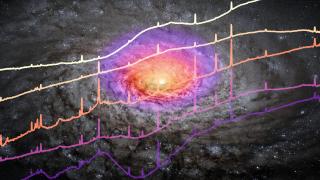Bibcode
Hermosa Muñoz, L.; Alonso-Herrero, A.; Pereira-Santaella, M.; García-Bernete, I.; García-Burillo, S.; García-Lorenzo, B.; Davies, R.; Shimizu, T.; Esparza-Arredondo, D.; Hicks, E. K. S.; Haidar, H.; Leist, M.; López-Rodríguez, E.; Ramos Almeida, C.; Rosario, D.; Zhang, L.; Audibert, A.; Bellocchi, E.; Boorman, P.; Bunker, A. J.; Combes, F.; Campbell, S.; Díaz-Santos, T.; Fuller, L.; Gandhi, P.; González-Martín, O.; Hönig, S.; Imanishi, M.; Izumi, T.; Labiano, A.; Levenson, N. A.; Packham, C.; Ricci, C.; Rigopoulou, D.; Rouan, D.; Stalevski, M.; Villar-Martín, M.; Ward, M. J.
Bibliographical reference
Astronomy and Astrophysics
Advertised on:
10
2024
Journal
Citations
24
Refereed citations
19
Description
We present observations of the type-2 Seyfert NGC 7172 obtained with the medium-resolution spectrometer (MRS) of the Mid-Infrared Instrument (MIRI) on board the James Webb Space Telescope (JWST). This galaxy hosts one of the lowest ionised gas mass outflow rates (Ṁout ∼ 0.005 M⊙ yr‑1) in a sample of six active galactic nuclei (AGN) with similar bolometric luminosities (log Lbol ∼ 44 erg s‑1) within the Galactic Activity, Torus, and Outflow Survey (GATOS). We aim to understand the properties of the ionised gas outflow and its impact on the host galaxy. We mainly used the ionised gas emission lines from the neon transitions, which cover a broad range of ionisation potentials (IPs) from ∼20 eV to ∼130 eV. We applied parametric and non-parametric methods to characterise the line emission and kinematics. The low excitation lines (IP < 25 eV, e.g. [Ne II]) trace the rotating disc emission. The high excitation lines (IP > 90 eV, e.g. [Ne V]), which are likely photoionised exclusively by the AGN, are expanding in the direction nearly perpendicular to the disc of the galaxy, with maximum projected velocities in the range of ∼350–500 km s‑1. In particular, [Ne V] and [Ne VI] lines reveal a biconical ionised gas outflow emerging north-south from the nuclear region, extending at least ∼2.5″ N and 3.8″ S (projected distance of ∼450 and 680 pc, respectively). Most of the emission arising in the northern part of the cone was not previously detected due to obscuration. Given the almost face-on orientation of the outflow and the almost edge-on orientation of the galaxy, NGC 7172 may be a case of weak coupling. Nevertheless, we found evidence of positive feedback in two distinct outflowing clumps at projected distances of 3.1″ and 4.3″ (i.e. ∼560 and 780 pc) south-west of the AGN. We estimated a star formation rate in these regions using the [Ne II] and [Ne III] luminosities of 0.08 M⊙ yr‑1, which is ∼10% of that found in the circumnuclear ring. The star formation activity might have been triggered by the interaction between the ionised gas outflow and the interstellar medium of the galaxy.
Related projects

Nuclear Activity in Galaxies: a 3D Perspective from the Nucleus to the Outskirts
This project consists of two main research lines. First, the study of quasar-driven outflows in luminous and nearby obscured active galactic nuclei (AGN) and the impact that they have on their massive host galaxies (AGN feedback). To do so, we have been granted time with the Gran Telescopio CANARIAS (GTC) in the optical and near-infrared ranges
Cristina
Ramos Almeida